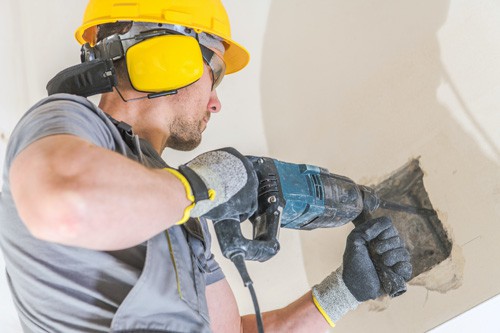First and foremost, make sure you’re wearing the right gear. This means safety glasses, a hard hat, gloves, and ear protection. Hammer drills are incredibly loud and can cause serious damage to your hearing, so it’s important to protect yourself. Additionally, you should always wear steel-toed boots to protect your feet from falling debris.
Next, make sure you’re using the right drill bit for the job. Using the wrong drill bit can cause the bit to break or the drill to malfunction, which can be dangerous. Always check the manufacturer’s instructions to make sure you’re using the right bit for your drill.
When drilling, make sure you’re using the proper technique. This means keeping your drill perpendicular to the surface you’re drilling into and applying steady pressure. Don’t push too hard, as this can cause the bit to become stuck or break. Instead, let the drill do the work and apply steady pressure until the hole is complete.
It’s also important to pay attention to the depth of the hole you’re drilling. Hammer drills can create deep holes quickly, but you don’t want to drill too deep and hit something you shouldn’t, like a water pipe or electrical wire. Always check the area you’re drilling in and mark off the depth you need to drill before you start.
One of the most important safety tips for using a hammer drill is to never, ever, remove the safety guard. The safety guard is there to protect you from debris and to keep the drill bit from hitting your hand or arm. Removing the safety guard is incredibly dangerous and can result in serious injury.
Another important safety tip is to never leave your hammer drill unattended. This means not leaving it running while you go get a drink or taking your eyes off it while it’s in use. Hammer drills can be unpredictable, and you never know when something might go wrong. Always stay focused and aware of your surroundings when using a hammer drill.
Finally, make sure you’re using your hammer drill in a safe environment. This means keeping the area around you clear of debris and other hazards, and making sure you’re not drilling into something that could cause a dangerous reaction. For example, if you’re drilling into concrete that has rebar in it, make sure you know where the rebar is located so you don’t accidentally drill into it.
In conclusion, hammer drills are incredibly powerful tools that can make construction projects easier and faster. However, they can also be incredibly dangerous if not used properly. By following these safety tips, you can make sure you’re using your hammer drill safely and avoiding potential injury. So, stay safe out there, my friends, and happy drilling!
Cheers,

![]()






